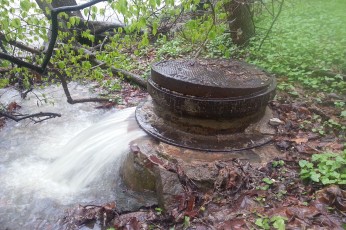From leaking sewage pipes to road salt, numerous sources of pollution negatively impact water quality in the Chesapeake Bay watershed, and millions of dollars have been invested both locally and regionally in trying to mitigate and reverse their effects. While small-scale assessments have been done to gauge the efficacy of individual mitigation practices, no clear picture existed of how pollution sources and clean-up efforts were impacting the intermediate watershed level as a whole.
A new report conducted by Blue Water Baltimore, the United States Geological Survey, and the Cary Institute of Ecosystem Studies, provides some answers. The Gwynns Falls Trends Analysis Study, supported by the Abell Foundation, examined over 20 years of water quality data in the Gwynns Falls watershed, a subsection of the larger Chesapeake Bay watershed. Thanks to the robust and detailed nature of the data set, researchers have been able to shed light on the leading factors that impact water quality over time.
The report presents three major conclusions:
- Stormwater projects appear to be making an impact: Best Management Practices (BMPs) such as bioswales, rain gardens, and retention ponds are designed to slow down and reduce the amount of polluted rain water that enters our waterways. The study found that the area treated by these projects is significantly correlated with reductions in the total amounts of phosphorus, phosphate, and sulfate measured in the water. Blue Water Baltimore views this as strong evidence that these projects should result in cleaner water and a healthier ecosystem.
- Sewage overflows are severely degrading water quality: Raw, untreated sewage carries a host of pathogens and nutrients that are harmful to ecological and human health. Blocked pipes or heavy rains that infiltrate through leaks and cracks in sanitary pipe systems lead to backups of raw sewage that are sometimes discharged into our streams through street-level manholes or at “overflow” points engineered for that purpose. This study found a significant relationship between these sewage overflows and increases in nitrate, total nitrogen, phosphate, and certain pathogens in the water. Blue Water Baltimore has long worked to end sewage flows that degrade our water quality in many more ways than stormwater infrastructure projects can address. Until we end the flow of sewage into our waterways, there will be no meaningful improvement in water quality overall.
- Climate Change is impacting the Gwynns Falls watershed: The Gwynns Falls watershed is getting wetter, a clear trend over the study’s 20-year timescale that is primarily driven by increased winter storms. This shift is particularly problematic because the additional rainfall is coming at a time when stormwater projects that rely on plants beds to soak up extra water are less effective as those plants become dormant for the season. Blue Water Baltimore is deeply concerned about stronger storms and greater rainfall, which over the years have been exacerbating pollution from stormwater runoff and putting more pressure on our sewage pipes and BMPs. These trends will likely continue, and implementing solutions will only become more costly the longer we wait.



